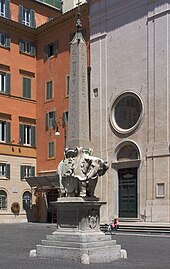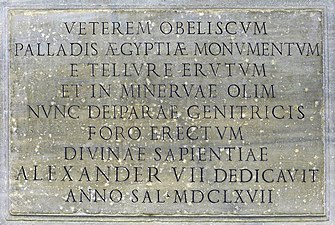Obelisco della Minerva

The Obelisco della Minerva is an Egyptian obelisk in Rome .
description
The Obelisk Minerveo made of rose granite originally stood in the Egyptian city of Sais , where it was built in 587 BC. Was built by Pharaoh Psammetich II . In Rome it was erected in front of the Temple of Isis ( Iseum Campense ) and found again in 1665 in the garden of the Dominican monastery of Santa Maria sopra Minerva . In 1667, Pope Alexander VII Chigi decided to put the obelisk in front of the monastery church. The Dominican Domenico Paglia proposed that it be placed on six small hills, as seen in the Chigi coat of arms, with a dog on each corner as a reference to the Dominicans, the domini canes (dogs of the Lord). The Pope rejected the plan and instructed Bernini .
Bernini's design placed the smallest of the Roman obelisks at 5.47 meters instead on an elephant. The idea probably goes back to the novel Hypnerotomachia Poliphili (1499) by Francesco Colonna , in which an artificial elephant (elephantina machina) is depicted with an obelisk on its back. The elephant is a masterpiece by the Ercole Ferrata who carried out the design. Since Paglia warned that the elephant would only be unable to carry the obelisk with its four legs, a massive plinth was left under its belly and hidden under a wide saddlecloth that reached to the floor.
The base is provided with two inscriptions:
The inscription B reads: Sapientis Aegypti / insculptas obelisco figuras / ab elephanto / belluarum fortissima / gestari quisquis hic vides / documentum intellige / robustae mentis esse / solidam sapientiam sustinere . This means that the elephant shows that a robust mind is required to endure solid wisdom. The word robust alludes to the oak in the coat of arms of the della Rovere family and Pope Alexander VII Chigi. Julius II della Rovere had allowed his banker Agostino Chigi to add the oak of della Rovere to the six hills in their coat of arms. Julius II owed the name and the coat of arms della Rovere in turn to his uncle Sixtus IV , who had inherited both from a Turin family to which he was not even related.
See also
literature
- Samuel Ball Platner, Thomas Ashby: A Topographical Dictionary of Ancient Rome. Oxford University Press, London 1929, pp. 368-369 ( online ).
- Cesare D'Onofrio: Gli obelischi di Roma. Rome 1967
- Erik Iversen: Obelisks in exile. Vol. 1: The obelisks of Rome. Gad, Copenhagen 1968.
- Ernst Batta: Obelisks. Egyptian obelisks and their history in Rome. Insel, Frankfurt a. M. 1986, ISBN 3-458-32465-8 ( Insel-Taschenbuch , 765).
- Klaus Bartels: Rome's speaking stones. 2nd edition, von Zabern, Mainz 2001, ISBN 3-8053-2690-4 .
- Wilfried Greiner, Bernhard Pelzl: Rome: Tell ruins. Böhlau Verlag, Vienna 1998, ISBN 3-205-98908-2 .
Web links
- The Roman Obelisks ( Memento from September 19, 2008 in the Internet Archive )
- Obelisco Minerveo (Italian)
Individual evidence
- ↑ Figure Elephantina machina at Wikimedia Commons
- ↑ Virtual Roma: Minerva's Chick (accessed November 14, 2015)
- ↑ This old obelisk, a monument of the Egyptian Pallas (= Isis), dug out of the earth and erected on the site, formerly Minerva, now the godlike Mother of God, was consecrated by Alexander VII to Divine Wisdom in the year of salvation in 1667.
- ↑ Take the signs carved on the obelisk by the wise men of Egypt, which you see here, carried by an elephant, the strongest of the animals, as proof that a strong spirit sustains healthy wisdom.
Coordinates: 41 ° 53 ′ 52.7 " N , 12 ° 28 ′ 39.2" E

